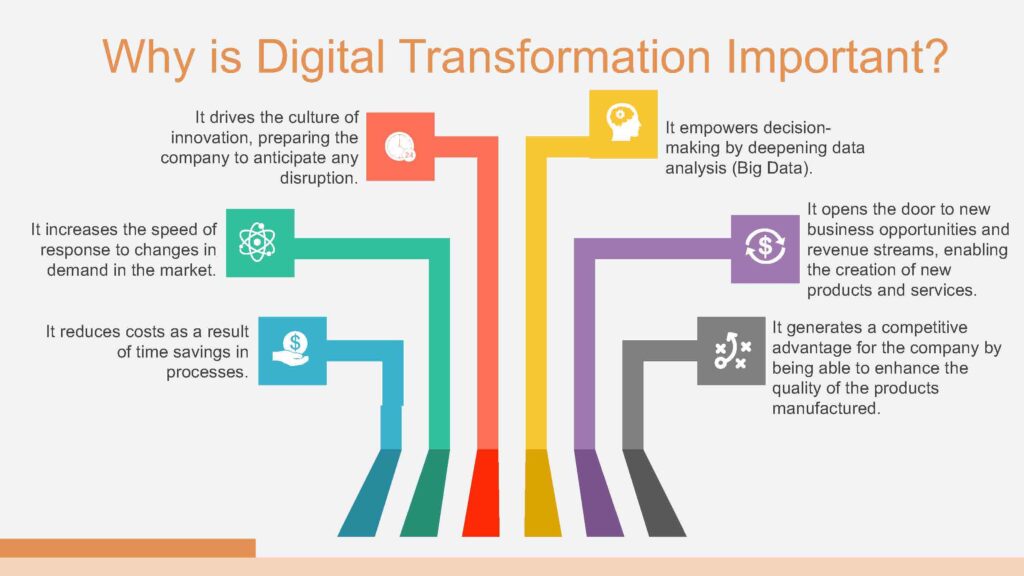The modern commercial enterprise panorama is characterized by rapid technological improvements, evolving customer preferences, and accelerated worldwide competition. For groups to succeed in such a dynamic environment, they have to embrace change at every stage, which can fuel creativity and improve productivity while ensuring continued development. This blog explores critical transformative commercial enterprise techniques that could help organizations live ahead of the curve and attain long-term achievement.
- Embrace Digital Transformation
- Invest in Digital Infrastructure:
Digital transformation is critical for cutting-edge groups. Enabling organizations to streamline operations, better manage information, and improve consumer ratings should they invest in robust virtual infrastructures like cloud computing, artificial intelligence (AI), or the Internet of Things (IoT). Scalable resources that can adjust according to business requirements immediately, guaranteeing performance and cost-effectiveness, are among the benefits of cloud-based solutions.
- Enhance Cybersecurity:
The importance of cybersecurity is growing as businesses become more digital. It is essential to keep information safe while ensuring the systems work correctly. Implementing superior cybersecurity measures, which include encryption, multi-issue authentication, and everyday security audits, facilitates protection against cyber threats and constructs consideration with clients and partners.
- Leverage Data Analytics:
Data is an essential resource in modern business technology. Leveraging information analytics permits agencies to benefit from insights into consumer behavior, market developments, and overall operational performance. Companies can make informed decisions using massive records and predictive analytics, personalize advertising and marketing efforts, and perceive new increase opportunities. Retailers like Walmart use statistics analytics to optimize stock control and enhance the buying experience.
- Foster Innovation and Agility
- Cultivate a Culture of Innovation:
Contemporary organizations thrive on new ideas. They must build a culture that promotes innovativeness, a trial-and-error approach to work, and risk-taking.
. Companies can do this by giving staff what they need, like time or resources, to think up fresh concepts, rewarding innovative thinking with prizes or promotions, and making failure an opportunity for learning in environments that encourage it, among other things.
- Implement Agile Methodologies:
Agile methodologies allow businesses to respond quickly to changes in the market and client desires. By adopting agile practices, including iterative improvement, go-purposeful teams, and continuous remarks loops, corporations can accelerate product development, improve collaboration, and deliver costs to clients quickly. Tech giants like Google and Spotify have correctly implemented agile methodologies to force innovation and stay aggressive.
- Encourage Intrapreneurship:
Intrapreneurship is letting employees run business operations inside their organization. This is so because it releases the technical and creative potential of a company’s staff members, which results in the development of fresh goods, services, or systems. Among other companies, 3M has always encouraged intrapreneurship, producing ground-breaking ideas like Post-it notes.
- Focus on Customer Experience
- Personalize Customer Interactions:
Personalization is fundamental to turning in terrific purchaser stories. Businesses can tailor their interactions to meet character options and wishes by leveraging purchaser information and AI-driven technology. Personalized advertising, product hints, and customer support interactions create engaging and satisfying enjoyment, fostering loyalty and retention. E-commerce structures like Amazon excel in personalization, using substantial purchaser delight and repeat commercial enterprise.
- Enhance Omnichannel Presence:
Modern customers expect seamless experiences across multiple channels, whether online, in-store, or through cellular apps. Making omnichannel more robust ensures uniformity and convenience in customer dealings. Enterprises may deliver a coherent experience by blending online and offline channels that meet clients at their locations. Among other retailers, Starbucks offers a seamless omnichannel experience via its mobile application, in-store services, and loyalty program.
- Prioritize Customer Feedback:
Listening to and acting on client comments is crucial for continuous improvement. Businesses should regularly accumulate feedback through surveys, critiques, and social media interactions. Analyzing this feedback allows them to perceive pain points, discover opportunities for improvement, and exhibit a dedication to client delight. Companies like Apple actively seek purchaser feedback to refine their services and products.
- Drive Sustainability and Social Responsibility
- Implement Sustainable Practices:
Commercial success is only possible with sustainability. Green strategies like reducing carbon footprints, reducing waste materials, and sourcing ethically also help protect the surroundings while enhancing brand reputation. Electric cars and renewable energy options have put companies such as Tesla at the top regarding sustainability.
- Engage in Corporate Social Responsibility (CSR):
CSR tasks display a dedication to social and environmental causes. Engaging in activities along with charitable donations, community tasks, and moral exertions practices helps construct a nice emblem picture and fosters client loyalty. Businesses that actively make contributions to their communities, like Ben
Five. Adapt to Market Changes
- Conduct Market Research:
Regular market studies help corporations stay informed about industry trends, competitive dynamics, and changing consumer alternatives. Organizations can anticipate shifts, discover possibilities, and make strategic choices by understanding the marketplace landscape. Market research companies like Nielsen offer precious insights that guide enterprise strategies.
- Explore New Revenue Streams:
Diversifying revenue streams enables the mitigation of dangers and pressure boom. Exploring new markets, launching new services or products, and pursuing strategic partnerships can create additional income resources. For example, Google’s diversification into hardware, cloud computing, and autonomous automobiles has extensively elevated its sales base.
- Stay Agile and Flexible:
Flexibility is essential for adapting to unexpected, demanding situations and possibilities. Businesses should be prepared to pivot their techniques in reaction to marketplace adjustments, monetary conditions, and technological improvements. The COVID-19 pandemic highlighted the importance of agility, as groups that quickly adapted to faraway paintings, e-trade, and digital services were highly placed to weather the disaster.
Conclusion
In the modern era, transformative enterprise techniques are critical for achieving sustainable growth and preserving competitiveness. By embracing virtual transformation, fostering innovation, specializing in purchaser revel, driving sustainability, and adapting to market adjustments, groups can navigate the complexities of today’s panorama and secure long-term success. As the commercial enterprise environment keeps conforming, the ability to innovate, adapt, and prioritize purchaser needs could be the key to thriving inside the present-day technology.




